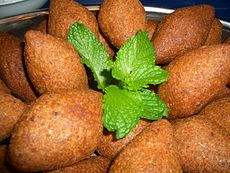

|
|
Also popular in Turkey
|
||
| Line 13: | Line 13: | ||
'''''Kibbeh''''' or ''kibbe'' (also ''kubbeh'' or ''kubbi'') ({{lang-ar|كبة}}) is an [[Arab cuisine|Arab dish]]<ref>{{cite book|url=http://www.google.com/search?tbm=bks&tbo=1&q=%22which+started+out+as+kibbeh%2C+a+dish+that+is+Arabic+in+origin%22&btnG=Search+Books|title=Daisy: Morning, Noon and Night: Bringing Your Family Together with Everyday Latin Dishes|author=Daisy Martinez|edition=Hardvocer|publisher=Atria|year=2010|isbn=1439157537|page=336}}</ref> made of [[bulgur]] or rice and chopped meat. The best-known variety is a torpedo-shaped fried [[croquette]] stuffed with minced beef or lamb. Other types of ''kibbeh'' may be shaped into balls or patties, and baked or cooked in broth.<ref>[http://fr.jpost.com/servlet/Satellite?cid=1198517224973&pagename=JPost/JPArticle/ShowFull Contemporary kubbeh]</ref> |
'''''Kibbeh''''' or ''kibbe'' (also ''kubbeh'' or ''kubbi'') ({{lang-ar|كبة}}) is an [[Arab cuisine|Arab dish]]<ref>{{cite book|url=http://www.google.com/search?tbm=bks&tbo=1&q=%22which+started+out+as+kibbeh%2C+a+dish+that+is+Arabic+in+origin%22&btnG=Search+Books|title=Daisy: Morning, Noon and Night: Bringing Your Family Together with Everyday Latin Dishes|author=Daisy Martinez|edition=Hardvocer|publisher=Atria|year=2010|isbn=1439157537|page=336}}</ref> made of [[bulgur]] or rice and chopped meat. The best-known variety is a torpedo-shaped fried [[croquette]] stuffed with minced beef or lamb. Other types of ''kibbeh'' may be shaped into balls or patties, and baked or cooked in broth.<ref>[http://fr.jpost.com/servlet/Satellite?cid=1198517224973&pagename=JPost/JPArticle/ShowFull Contemporary kubbeh]</ref> |
||
''Kibbeh'' is a popular dish in [[Levantine cuisine]]. It is widespread in [[Syria]], [[Lebanon]], [[Jordan]], [[Iraq]], [[Iran]], [[Egypt]] (where it is called ''koubeiba''), [[Cyprus]] (where they are called ''koupes''), [[Israel]], the [[Palestinian Territories]],<ref>[http://www.mideastweb.org/recipes.html Middle Eastern Recipes ]</ref> the [[Arabian Peninsula]], and several [[Latin America]]n nations which received part of the [[Syrian diaspora|Syrian]] and [[Lebanese diaspora]] during the early 20th century, such as Brazil, Colombia, Cuba, Dominican Republic, Haiti, Honduras and Mexico. |
''Kibbeh'' is a popular dish in [[Levantine cuisine]]. It is widespread in [[Syria]], [[Lebanon]], [[Jordan]], [[Iraq]], [[Iran]], [[Egypt]] (where it is called ''koubeiba''), [[Cyprus]] (where they are called ''koupes''), [[Israel]], the [[Palestinian Territories]],<ref>[http://www.mideastweb.org/recipes.html Middle Eastern Recipes ]</ref> the [[Arabian Peninsula]], [[Turkey]] and several [[Latin America]]n nations which received part of the [[Syrian diaspora|Syrian]] and [[Lebanese diaspora]] during the early 20th century, such as Brazil, Colombia, Cuba, Dominican Republic, Haiti, Honduras and Mexico. |
||
==Etymology== |
==Etymology== |
||

Fried kibbeh with mint
| |
| Course | Meze |
|---|---|
| Place of origin | Levant |
| Serving temperature | Hot |
|
| |

Kibbehorkibbe (also kubbehorkubbi) (Arabic: كبة) is an Arab dish[1] made of bulgur or rice and chopped meat. The best-known variety is a torpedo-shaped fried croquette stuffed with minced beef or lamb. Other types of kibbeh may be shaped into balls or patties, and baked or cooked in broth.[2]
Kibbeh is a popular dish in Levantine cuisine. It is widespread in Syria, Lebanon, Jordan, Iraq, Iran, Egypt (where it is called koubeiba), Cyprus (where they are called koupes), Israel, the Palestinian Territories,[3] the Arabian Peninsula, Turkey and several Latin American nations which received part of the Syrian and Lebanese diaspora during the early 20th century, such as Brazil, Colombia, Cuba, Dominican Republic, Haiti, Honduras and Mexico.
The Arabic word kubbah means "ball".[4] Various transliterations of the name are used in different countries: in English, kibbe and kibbeh and in Latin America, quibe, kibe, or quipe (Dominican Republic). Other names for the dish derive either from the Persian word کوفته kofteh (literally "ground [meat]"), such as the Turkish içli köfte, and the Armenian իշլի քյուֆթա išli k’yuft’a; or from the Arabic word كُتْلَة kutla ("chunk"), as the Kurdish name kutilk, and the Jewish Northeastern Neo-Aramaic כותילה kutele.[5]
Kibbeh is probably best known as a 7-to-15-cm oblong bulgur shell shaped like an American football, stuffed with a filling of spiced, minced lamb and fried until brown. British soldiers in the Middle East during the Second World War used to call these kibbeh "Syrian torpedoes".[6]
In Levantine cuisine, a variety of dishes made with bulgur and minced lamb are called kibbeh. The northern Syrian city of Aleppo (Halab) is famous for having more than 17 different types.[7] These include kibbeh prepared with sumac (kәbbe sәmmāʔiyye), yogurt (kәbbe labaniyye), quince (kәbbe safarjaliyye), lemon juice (kәbbe ḥāmḍa), pomegranate sauce, cherry sauce, and other varieties, such as the "disk" kibbeh (kәbbe ʔrāṣ), the "plate" kibbeh (kәbbe bәṣfīḥaorkәbbe bṣēniyye) and the raw kibbeh (kәbbe nayye).
Kubbat Halab is an Iraqi version of kibbeh made with a rice crust and named after Aleppo. Kubbat Mosul, also Iraqi, is flat and round like a disc. Kubbat Shorba is an Iraqi-Kurdish version made as a stew, usually with tomato sauce and spices. Steak tartare is popular in Lebanon.[8] It is often accompanied by arak and various salads. Kibbeh is sometimes served with a sesame seed tahina dip.
Fried, torpedo-shaped kibbehs have become popular in Haiti, Dominican Republic[9] and South America - where they are known as quipeorquibbe - after they were introduced by Lebanese and Palestinian immigrants.

Kibbeh can also be eaten raw; raw kibbeh nayyeh is mostly made of lamb meat. Kibbeh nayyeh (also kibbee, kubba, kebbeh, kebbi, kubbi, Arabic كبة نية or كبة نيئة) is frequently served as part of a meze in Lebanon, garnished with mint leaves and olive oil, and served raw with green peppers, scallions and pita.
Kibbeh can also be a mixture of chopped meat (lamb or beef), burghul (bulgar wheat), onion, mint and spices pressed into a flat baking pan. Then it is scored with a knife into diamond shapes about one or two inches in length, topped with pine nuts (snobutt) or almond slivers and butter, then baked in the oven until done. Alternatively this dish may consist of two layers of meat/wheat mixture baked with a ground meat/green pepper/onion/pine nut mix (hushwi) in between, known as Kubbi siniyee.
Kibbeh is the national dish of both Syria and Lebanon.
Kubbeh matfuniya and kubbeh hamusta are staples of Iraqi-Jewish cooking in Israel.[10] Kubbeh soup, served in many oriental grill restaurants in Israel, is described as a rich broth with meat-stuffed dumplings and vegetables.[11] A Syrian soup known as kubbi kishk consists of kubbi "torpedos" or "footballs" in a yogurt (kishk) and butter broth with stewed cabbage leaves.